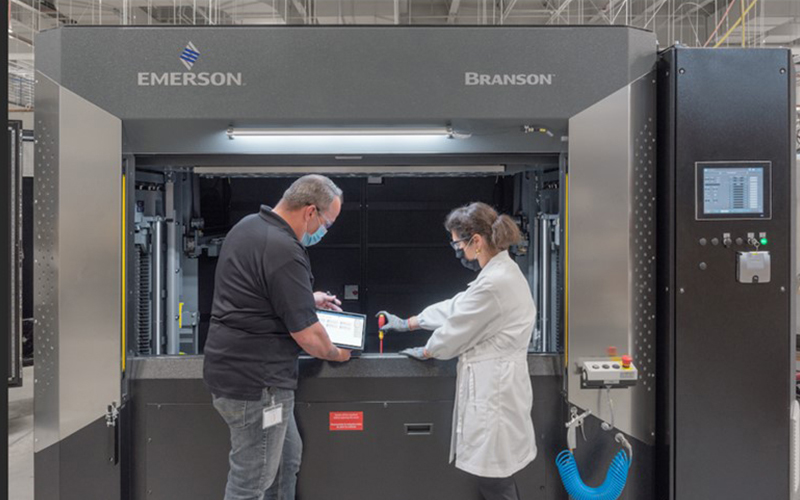by Sukumara Repuri, director, global aftermarket of assembly technologies,
and Sophie Morneau, director, global strategic accounts of assembly technologies, Emerson
Aftermarket services – delivered to manufacturers by the OEM of critical equipment – are becoming increasingly important in today’s challenging economies, where the pressure to produce quality products on time with limited budgets never seems to diminish and internal maintenance talent is increasingly hard to find. Calling in outside service techs when things go wrong might provide a partial solution, but an aftermarket partnership with an OEM is a much smarter approach.
With the help of a growing array of web-based tools, including the Internet of Things (IoT), companies assist customers by offering a full range of support services. Customized aftermarket programs, delivered through a combination of regional service centers and dedicated service specialists in virtually any location domestically and worldwide, focus on delivering several key services.
Maximizing Capability of Equipment
While it is vital to have solid OEM support for the installation, commissioning and startup of new production equipment, that support cannot be just a one-time event. The razor-sharp focus on maintaining optimal equipment performance – so clear at the launch of a new line – can be lost as the production mix shifts, operating personnel change, or new tasks or emergencies arise. In time, equipment that was once up to date, perfectly calibrated and expertly operated and maintained begins to age. Tooling wears, errors or alarms occur more frequently, and updates or maintenance recommendations are overlooked.
This is why it is important to maintain OEM aftermarket relationships throughout the life cycle of production equipment. This, in turn, demands a carefully planned preventive maintenance program. Whether inspections occur monthly, quarterly or annually, they should include:
- Scheduled equipment inspection
- Safety functions verification
- Control system testing
- Consumables replacement
Tracking Equipment and Managing Its Life Cycle
It is typical for large manufacturers to relocate their equipment from plant to plant to meet customers’ production and service demands. As a result, it becomes easy to lose track of valuable production equipment information, particularly when the equipment is portable.
It is also easy to lose sight of the age of equipment and, therefore, for equipment to become obsolete. Since equipment can typically be in service for an extended period of time, we recommend a periodic “walkdown” conducted by OEM supplier personnel to audit the status of plant equipment and trace its evolution through its life cycle. These equipment reviews typically:
- Identify installed equipment (quantity, model and serial number, control system and software versions, asset identification number, location)
- Visually inspect for operation and identify alarms or faults
- Evaluate maintenance needs such as lubrication for moving parts and proper installation of connections
This data is then compiled and reviewed with equipment engineering and support teams, and a detailed report includes a breakdown of equipment by age, condition, capabilities, current status and upgrade potential. It also lists detailed recommendations for:
- Corrective and preventive maintenance
- Calibration
- Repairs
- Upgrade opportunities
- Replacement of obsolete equipment
Rapidly Accessing Parts and Repairs
The ideal equipment supplier can deliver support for standard and custom products – everything from local equipment and parts inventory to the expertise needed to ensure proper integration, ongoing maintenance and spares, periodic calibration and software updates. A partner with regional service locations and parts hubs can ensure access to an inventory of critical parts, together with the skilled personnel needed to install and service equipment. To protect critical operations, consider a service agreement that includes priority access to parts, on-site or 24/7 access to service personnel, and other assurances geared to production requirements.
Updating Training
Ongoing training is a must in the real world, where production changes; processes evolve and trained personnel move around, get promoted or leave the organization, leaving a skills gap behind. Productivity can sag as process and equipment knowledge is lost or maintenance skills and scheduling are disrupted. Finding the right people to fill that gap can be difficult. An aftermarket partner can help, offering technical resources suited to keeping the workforce positioned with the knowledge they need to stay productive – in processes, equipment operation and maintenance skills.
Keeping employees up to date and equipment running reliably at all times is a constant challenge, but global partners – and a growing array of data-enabled technology – are on hand to help.
Sukumara Repuri is the director of Global Aftermarket of Assembly Technologies at Emerson. Repuri leads a global team of service specialists who help customers maximize their asset performance and reliability with Branson maintenance services. Sophie Morneau is the director of Global Strategic Accounts of Assembly Technologies at Emerson. Morneau works closely with global customers, providing solutions to help them navigate challenges and reach their goals in an increasingly competitive market.
Emerson, headquartered in St. Louis, Missouri, is a global technology and engineering company providing innovative solutions for customers in industrial, commercial and residential markets. Its automation solutions business helps process, hybrid and discrete manufacturers maximize production, protect personnel and the environment while optimizing their energy and operating costs.
More information: www.Emerson.com.




